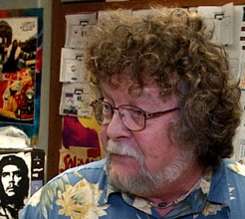Todd Finley -
 My town borders a military base. Almost all my students have a father or brother or sister serving. In meeting these soldiers, I find they have the dignity of redwoods. To question the premise of our foreign engagements would be like shredding their bark. Yet, teaching war must go beyond the "good-evil" rhetoric of politicians and spin doctors and focus instead on the nuances: How and why do we get into wars? Is war working as a means to resolve our conflicts?
My town borders a military base. Almost all my students have a father or brother or sister serving. In meeting these soldiers, I find they have the dignity of redwoods. To question the premise of our foreign engagements would be like shredding their bark. Yet, teaching war must go beyond the "good-evil" rhetoric of politicians and spin doctors and focus instead on the nuances: How and why do we get into wars? Is war working as a means to resolve our conflicts?
The Danger of Asking Hard Questions
In a neighboring school district, a high school principal refused to allow students to dramatize the United States' military presence in Iraq. The topic, he asserted, was "too sensitive." Authorized classroom conversations and texts related to war tend to be removed by history or geography. The Diary of Anne Frank meets both criteria. Additionally, almost every passage is chillingly intimate, thus making it a popular, albeit still challenged, curricular choice.
Awkward classroom silences and rolled eyes accompany teachers who espouse opinions about war profiteering. The only safe places to discuss, write about, or dramatize war are where everyone agrees with everyone else, or where the instructor has created a climate of trust. Teachers who introduce discussions of contemporary military engagements by the United States risk community blowback. Anti-war talk can be perceived as unpatriotic. Talk radio still pillories Jane Fonda, not for ruining a generation of female knees with her videos on high impact aerobics, but for her anti-war views. The threat is real for teachers who risk asking questions.




 Eight years ago today, a contingent of socialist youth calling themselves Students against the Draft and War, challenges the school administration at Foss high school in Tacoma Washington, when told that their intention to have a meeting to organize a counter-recruitment action against military recruiters on their campus would not be permitted. Below is a re-posting of the documentation of the event, including the telling by the lead organizer, Clara Lightner, and the news stories that followed, the victory of these youth to prevail against the military recruiters in their school, and the follow-up interview with Clara.
Eight years ago today, a contingent of socialist youth calling themselves Students against the Draft and War, challenges the school administration at Foss high school in Tacoma Washington, when told that their intention to have a meeting to organize a counter-recruitment action against military recruiters on their campus would not be permitted. Below is a re-posting of the documentation of the event, including the telling by the lead organizer, Clara Lightner, and the news stories that followed, the victory of these youth to prevail against the military recruiters in their school, and the follow-up interview with Clara.
 By unanimous vote, the entire faculty at Garfield High School in Seattle voted not to administer the MAP test of reading and mathematics.
By unanimous vote, the entire faculty at Garfield High School in Seattle voted not to administer the MAP test of reading and mathematics.





